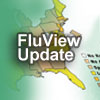Seasonal Influenza Activity Update
This podcast is presented by the Centers for Disease Control and Prevention. CDC – safer, healthier people.
Welcome to this CDC Seasonal Flu Update. I'm Dr. Tony Fiore from the Influenza Division in CDC’s National Center for Immunization and Respiratory Diseases.
We had a relatively late start to influenza activity in the United States this season. Influenza activity most often peaks in February, but this season we didn't see significant influenza activity begin until February. Since then, flu activity has been increasing rapidly. Based on information from our surveillance systems, the number of outpatient visits for influenza-like illness has been above national baseline levels for four consecutive weeks. By the end of February, 31 states were reporting widespread influenza activity and 16 states were reporting regional activity.
As the season progresses, CDC compares immunologic and genetic information from the most common viruses circulating with the viruses represented in the vaccine, in a process called antigenic characterization. Thus far this season, influenza A H1N1 viruses are the most common circulating viruses, with a smaller proportion of influenza B viruses and an even smaller proportion of influenza A H3N2 viruses circulating. The good news is that this season's vaccine is an excellent match for all circulating influenza A viruses. However, about 75 percent of the influenza B viruses so far have been from a different lineage than the influenza B virus in the vaccine, suggesting that the influenza B component of the vaccine will not work well against these viruses.
Because of the late start to the flu season in the United States, we could continue to see influenza activity for some time. In some seasons, influenza activity has continued into May. For this reason, CDC recommends that people who have not yet gotten vaccinated this season should get vaccinated. Getting vaccinated now can still offer protection against late-circulating viruses and provide immunity from flu through the season.
Ongoing antiviral resistance testing has confirmed that about 98 percent of influenza A H1N1 viruses are resistant to the antiviral drug oseltamivir. For this reason, CDC issued interim guidance for health care professionals in December 2008 on the use of antiviral medications for this season. This guidance recommends that when influenza A H1N1 virus infection or exposure is suspected or type and subtype is not known, zanamivir or a combination of oseltamivir and rimantadine are more appropriate treatment or prevention options. Oseltamivir alone should not be used if H1N1 viruses are the cause of illness. Additionally, as of the end of February, CDC had received reports of 22 influenza-associated pediatric deaths occurring this season. These deaths are a somber reminder of the importance of protecting children from flu by getting a flu vaccination.
Children younger than nine who are getting vaccinated for the first time need two doses to get full protection, so these children should get that second dose now if they did not already get it. On a related note, in February, the Advisory Committee on Immunization Practices voted to fully implement the recommendation to vaccinate all children from 6 months of age up until their 19th birthday for next season. Providers should be prepared to implement that recommendation for the upcoming 2009-2010 season.
For more information about seasonal flu activity during the 2008-2009 flu season, please visit CDC’s website at www.cdc.gov/flu.
For the most accurate health information, visit www.cdc.gov or call 1-800-CDC-INFO, 24/7.


